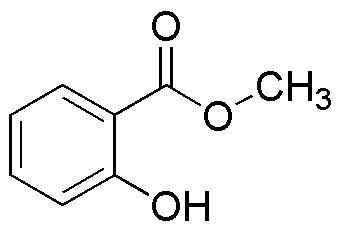Methyl salicylate is widely utilized in research focused on:
- Topical Analgesics: Commonly found in pain relief creams and ointments, it provides soothing effects for muscle and joint pain, making it popular in sports medicine and physical therapy.
- Flavoring and Fragrance: Used as a flavoring agent in food products and as a fragrance in cosmetics and personal care items, it offers a pleasant wintergreen scent that enhances product appeal.
- Pharmaceuticals: Acts as a solvent and a carrier for various medications, improving the delivery and effectiveness of active ingredients in formulations.
- Research Applications: Employed in laboratories for synthesizing other compounds and studying its properties, aiding researchers in organic chemistry and material science.
- Insect Repellents: Utilized in some natural insect repellent formulations, providing an alternative to synthetic chemicals while being effective against certain pests.
General Information
Properties
Safety and Regulations
Applications
Methyl salicylate is widely utilized in research focused on:
- Topical Analgesics: Commonly found in pain relief creams and ointments, it provides soothing effects for muscle and joint pain, making it popular in sports medicine and physical therapy.
- Flavoring and Fragrance: Used as a flavoring agent in food products and as a fragrance in cosmetics and personal care items, it offers a pleasant wintergreen scent that enhances product appeal.
- Pharmaceuticals: Acts as a solvent and a carrier for various medications, improving the delivery and effectiveness of active ingredients in formulations.
- Research Applications: Employed in laboratories for synthesizing other compounds and studying its properties, aiding researchers in organic chemistry and material science.
- Insect Repellents: Utilized in some natural insect repellent formulations, providing an alternative to synthetic chemicals while being effective against certain pests.
Documents
Safety Data Sheets (SDS)
The SDS provides comprehensive safety information on handling, storage, and disposal of the product.
Product Specification (PS)
The PS provides a comprehensive breakdown of the product’s properties, including chemical composition, physical state, purity, and storage requirements. It also details acceptable quality ranges and the product's intended applications.
Certificates of Analysis (COA)
Search for Certificates of Analysis (COA) by entering the products Lot Number. Lot and Batch Numbers can be found on a product’s label following the words ‘Lot’ or ‘Batch’.
*Catalog Number
*Lot Number
Certificates Of Origin (COO)
This COO confirms the country where the product was manufactured, and also details the materials and components used in it and whether it is derived from natural, synthetic, or other specific sources. This certificate may be required for customs, trade, and regulatory compliance.
*Catalog Number
*Lot Number
Safety Data Sheets (SDS)
The SDS provides comprehensive safety information on handling, storage, and disposal of the product.
DownloadProduct Specification (PS)
The PS provides a comprehensive breakdown of the product’s properties, including chemical composition, physical state, purity, and storage requirements. It also details acceptable quality ranges and the product's intended applications.
DownloadCertificates of Analysis (COA)
Search for Certificates of Analysis (COA) by entering the products Lot Number. Lot and Batch Numbers can be found on a product’s label following the words ‘Lot’ or ‘Batch’.
*Catalog Number
*Lot Number
Certificates Of Origin (COO)
This COO confirms the country where the product was manufactured, and also details the materials and components used in it and whether it is derived from natural, synthetic, or other specific sources. This certificate may be required for customs, trade, and regulatory compliance.


